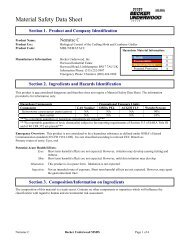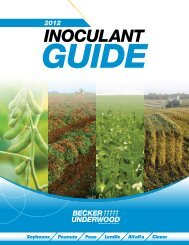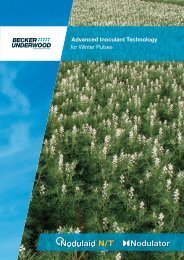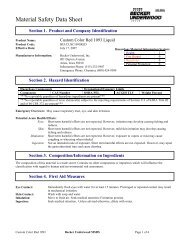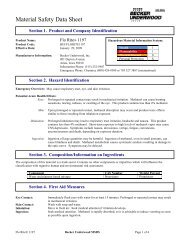beneficial nematode applications - Becker Underwood
beneficial nematode applications - Becker Underwood
beneficial nematode applications - Becker Underwood
You also want an ePaper? Increase the reach of your titles
YUMPU automatically turns print PDFs into web optimized ePapers that Google loves.
How Can You Use Beneficial Nematodes<br />
Whether your interest in using <strong>beneficial</strong> <strong>nematode</strong>s is driven by a sustainability initiative<br />
or by chemical resistance issues you have experienced, there are a variety of ways to<br />
evaluate their place in your operation.<br />
Compatibility<br />
Nematodes can be used as a standalone program or in rotation with conventional<br />
insecticides to effectively control pest populations. Because insect parasitic <strong>nematode</strong>s have<br />
no adverse affects on <strong>beneficial</strong> insects or microorganisms, <strong>nematode</strong>s also can be used in<br />
conjunction with other BCAs to broaden the pest control spectrum. <strong>Becker</strong> <strong>Underwood</strong><br />
provides a compatibility chart so you know what products work in combination with our<br />
<strong>beneficial</strong> <strong>nematode</strong>s.<br />
Chemical Use<br />
Using BCAs to manage pest populations can reduce the number of insecticide <strong>applications</strong><br />
needed. Therefore, <strong>beneficial</strong> <strong>nematode</strong>s can be an extremely effective tool in your IPM<br />
program.<br />
Re-Entry Interval<br />
Beneficial <strong>nematode</strong> products have no re-entry interval. This means it is safe to enter the<br />
application area immediately following spraying of <strong>nematode</strong>s. If other pesticides or<br />
chemicals are included with the application, check their labels for REI information.<br />
Resistance Concerns<br />
There is no risk of insect pests developing a resistance to <strong>beneficial</strong> <strong>nematode</strong>s. Many<br />
species of insects can develop resistance to certain chemicals that have been applied<br />
frequently. That is not a concern with <strong>beneficial</strong> <strong>nematode</strong>s. They physically enter the body<br />
of the pest and release a bacterium that causes the death of the insect.<br />
Safety<br />
Beneficial <strong>nematode</strong>s are host-specific and only affect targeted insect pests. They are<br />
harmless to any organism – human, plant, animal – other than susceptible insects. Because<br />
<strong>beneficial</strong> <strong>nematode</strong>s are non-toxic and harmless to humans, there is no need for applicators<br />
to wear protective gear, and no disposal restrictions.<br />
Application Requirements<br />
Because <strong>beneficial</strong> <strong>nematode</strong>s are living organisms, they demand more specific<br />
environmental conditions.






